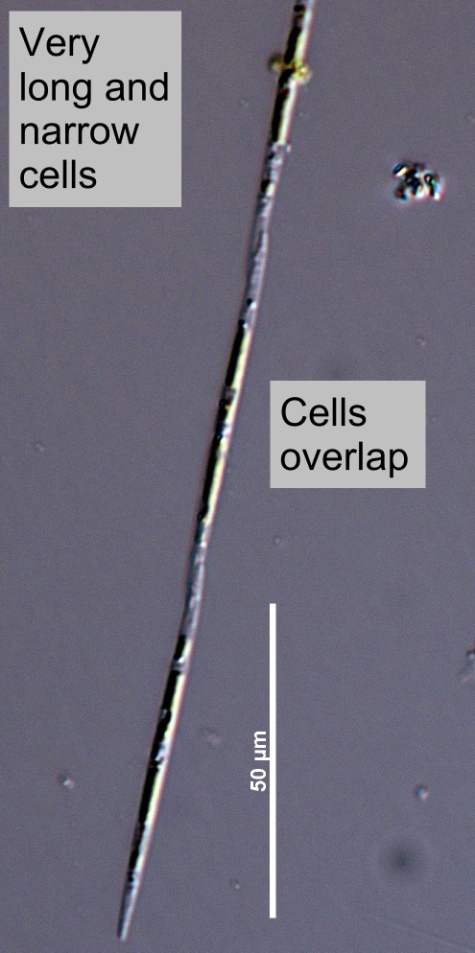

|
Synonym(s)
Heterotypic
A difference in type. In naming species, a heterotypic synonym is one that comes into being when a taxon becomes part of a different taxon. Compare to homotypic.
(heterotypic)Nitzschia delicatissima Cleve 1897 Close
Basionym
The original name for an organism. In botany, the original published nomenclature from which a new binomial nomenclature is derived for a particular group of organisms (Tindall 1999).
(basionym, CloseHomotypic
Expressing the same fundamental type or structure; may or may not be symmetrical (e.g., the two valves of a diatom, where they are the same shape and appearance, but one is bigger than the other). In naming species, a homotypic synonym is one that comes into being when a taxon gets a new name (without being added to an already existing taxon).
homotypic)(Guiry and Guiry 2012)
Classification
(Guiry and Guiry 2012)
Lifestyle
Description
Sigmoid
S-shaped.
sigmoid in CloseGirdle
In diatoms, the portion of the cell wall between the two valves of a cell; made up of intercalary bands (bands closest to the valves) and connecting bands (bands in the middle of the girdle). In dinoflagellates, the equivalent of a cingulum or transverse furrow (Horner 2002).
girdle view. A large central interspace is present (area devoid of pores visible only in EM; Hasle and Syvertsen 1997).SEM
(scanning electron microscope) A microscope which applies "a focused beam of high-energy electrons to generate a variety of signals at the surface of solid specimens" (NSF 2011).
SEM is not available, identify these narrower (< 3 μm) species as "P. delicatissima complex."Measurements
Apical
(axis, spine) The region of the apex or point. Refers to the most anterior point or region of the cell (HPP 2003).
(apical axis): 40 - 76 μmWidth Close
Transapical axis
In diatoms, the longitudinal axis of the valve.
(transapical axis): ∼2 μmHeight Close
Pervalvar axis
The axis through the centre point of the two valves of a frustule. This axis is perpendicular to the valve face.
(pervalvar axis): 1.5 - 2 μmClose
Striae
(referring to pores in diatoms) In diatoms, a striation or row of pores on the valve face. "In centric diatoms, striae may be radial, running from the centre of the valve to the margin ... In pennate diatoms, striae may be parallel to the median line of the valve or raphe" (Horner 2002).
Striae: 36 - 40 in 10 μmFibulae: 19 - 25 in 10 μm
(Hasle and Syvertsen 1997, Kraberg et al. 2010)
Similar species
Harmful effects
Habitat
Distribution
Cosmopolitan (Hasle and Syvertsen 1997).
Found mainly in the summer, sometimes in high abundances, around Northern European seas (Kraberg et al. 2010). Blooms in early spring and fall on the Mediterranean coast (Ribera d'Alcalà et al. 2004). Forms non-toxic blooms in spring in Scottish waters (Fehling 2004).
Present throughout the summer. Sometimes found in high numbers in conjunction with colonies of Chaetoceros socialis.
Growth conditions
Photoperiod
The amount of time in a day that an organism is exposed to daylight. This varies between seasons, with photoperiods being longer in the summer and shorter in the winter.
photoperiods, such as those during the spring (Fehling et al. 2005). May be favoured by high concentrations of dissolved organic matter, such as after blooms of other species (Loureiro et al. 2009). More readily uses ammonium than urea as a source of nitrogen, but may use urea under low nitrogen conditions (Loureiro et al. 2009).Environmental Ranges
Temperature range (°C): -2.045 - 29.468
Nitrate (μmol L-1): 0.030 - 28.280
Salinity: 24.378 - 37.775
Oxygen (mL L-1): 3.756 - 9.116
Phosphate (μmol L-1): 0.046 - 2.337
Close
Silicic acid
A general term to describe chemical compounds containing silicon, oxygen and hydrogen with a general formula of [SiOx(OH)4-2x]n. Diatoms polymerize silicic acid into biogenic silica to form their frustules (Azam and Chisholm 1976).
Silicate (μmol L-1): 0.648 - 59.039(OBIS 2012, cited in EOL 2012)
Bloom characteristics
References
Encyclopedia of Life (EOL). 2012. Pseudo-nitzschia delicatissima. http://eol.org/pages/912940/overview. Accessed 17 Mar 2012.
Fehling, J. 2004. Diversity, ecology and domoic acid production of Pseudo-nitzschia spp. in Scottish waters. Ph.D. Dissertation. Open University, UK. 309.
Fehling, J., Davidson, K. and Bates, S. S. 2005. Growth dynamics of non-toxic Pseudo-nitzschia delicatissima and toxic P. seriata (Bacillariophyceae) under simulated spring and summer photoperiods. Harmful Algae. 4: 763-769.
Guiry, M. D. and Guiry, G. M. 2012. Pseudo-nitzschia delicatissima (Cleve) Heiden. http://www.algaebase.org/search/species/detail/?species_id=39544. Accessed 17 Mar 2012.
Hasle, G. R. and Syvertsen, E. E. 1997. Marine diatoms. In: Tomas, C. R. (ed.) Identifying Marine Phytoplankton. Academic Press, Inc., San Diego. 5-385.
Kraberg, A., Baumann, M. and Durselen, C. D. 2010. Coastal Phytoplankton: Photo Guide for Northern European Seas. Verlag Dr. Friedrich Pfeil, Munchen, Germany. 204.
Loureiro, S., Jauzein, C., Garcés, E., Collos, Y., Camp, J. and Vaqué, D. 2009. The significance of organic nutrients in the nutrition of Pseudo-nitzschia delicatissima (Bacillariophyceae). Journal of Plankton Research. 31(4): 399-410.
Ocean Biogeographic Information System (OBIS). 2012. Pseudo-nitzschia delicatissima. http://www.iobis.org/mapper/?taxon_id=499391. Accessed 17 Mar 2012.
Orsini, L., Procaccini, G., Sarno, D. and Montresor, M. 2004. Multiple rDNA ITS-types within the diatom Pseudo-nitzschia delicatissima (Bacillariophyceae) and their relative abundances across a spring bloom in the Gulf of Naples. Marine Ecology Progress Series. 271: 87-98.
Ribera d'Alcalà, M., Conversano, F., Corato, F., Licandro, P., Mangoni, O., Marino, D., Mazzocchi, M. G., Modigh, M., Montresor, M., Nardella, M., Saggiomo, V., Sarno, D. and Zingone, A. 2004. Seasonal patterns in plankton communities in a pluriannual time series at a coastal Mediterranean site (Gulf of Naples): an attempt to discern recurrences and trends. Scientia Marina. 68(Suppl. 1): 65-83.
